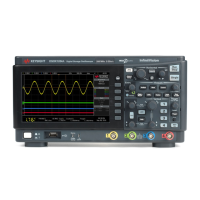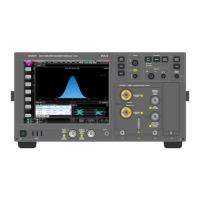26 DSOX1204A/G Oscilloscopes Service Guide
2 Testing Performance
3 Set up the oscilloscope.
a Press the [Default Setup] key.
b Set channel 1 Coupling to DC.
c Set the time base to 500 ns/div.
d Set the Volts/Div for channel 1 to 200 mV/div.
e Press the [Acquire] key, then press the Averaging softkey.
f Turn the Entry knob to set # Avgs to 8 averages.
4 Set the signal generator for 1 MHz and six divisions of amplitude.
The signal on the oscilloscope screen should be about five cycles at six
divisions amplitude.
5 Set up the Amplitude measurement
a Press the [Meas] key.
b Press the Clear Meas softkey and then the Clear All softkey.
c Press the Type: softkey and use the Entry knob to select AC RMS - N Cycles
within the select menu.
d Press the Add Measurement softkey.
6 Note the oscilloscope AC RMS - Cyc(1) reading at the bottom of the screen.
(This is the RMS value with any dc offset removed.)
7 Set the power meter Cal Factor % to the 1 MHz value on the calibration chart
on the power sensor.
8 Note the reading on the power meter and covert to Vrms using the expression:
For example, if the power meter reading is 892 uW, then Vin
1MHz
= (892*10
-6
*
50Ω)
1/2
= 211.2 mV
rms
.
9 Change the signal generator output frequency according to the maximum
frequency for the oscilloscope using the following:
• 200 MHz Models: 200 MHz
• 100 MHz Models: 100 MHz
• 70 MHz Models: 70 MHz
10 Referencing the frequency from step 9, set the power meter Cal Factor % to the
frequency value on the calibration chart on the power sensor.

